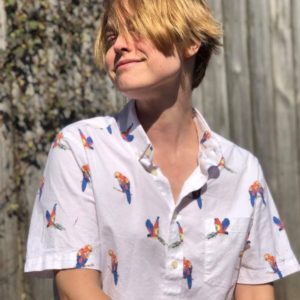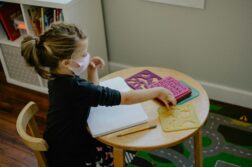AROUND 2013 I noticed a new thought gnawing at my mind. No, I thought, it’s not possible. I thought about all the reasons it couldn’t be true, flipping through photographic evidence from political rallies to concerts to dresses. I’m a girl. Everyone knows it.
I hopped into chat rooms—yes, chat rooms still existed—as a trans guy named Clive. I dreamed up a whole character for him. I assumed this impulse stemmed from my PTSD and was simply a fantasy about being someone else. Clive was confident and athletic and had a Gothic, rugged Adam Lambert aesthetic.
He didn’t stay in the chat room. I was planning for the future for the first time, and it was easier to imagine myself as an old man than an old woman, as a dad than a mom. I felt like a charlatan in groups of women, even when they were all queer. I was surprised every time I saw myself in the mirror, and had been for as long as I could remember. I’d once argued with transphobic people; now, even being near them overwhelmed me with panic. I stopped dressing high-femme, because it used to feel like I gained power with every compliment, but now it felt icky. I dreamed of being two different people: an embattled woman the world had already proven they’d kind of accept and a flamboyant man whom they might not. He would stay hidden, just to be safe.
In early 2017, I asked my fiancée if she was sure she wanted to marry me—even if my depression got scary again, even if I turned out to be a guy. She did. I continued to talk to her about my feelings, but not to anyone else, save the occasional therapist. She started calling me a boy in private. It felt wonderful.

I anonymously posted on Reddit. They told me to meet some other trans people, read Stone Butch Blues. They were nice, but I bristled. I read Stone Butch Blues fifteen years ago, thank you very much! I’ve had trans friends since George W.! I once drunk-texted Kate Bornstein! I had written a novel about growing up lesbian.
If this were a real thing, I thought, wouldn’t it have come up then? Surely it was too late.
In 2018, Daniel Lavery told Autostraddle: “It turns out I’m trans.” Every word he spoke after that sounded like my interior monologue, only confident.
More than a decade after it happened, I thought about the fact that it took me until college to start publicly dating women. A sense of My life cannot possibly fit anything else haunted me. I’d been the Sick Kid by the time I turned ten, the one everyone felt entitled to follow around asking invasive questions and harassing about their diet. I safely rebelled by defending my gay friends, supporting marriage equality. I dated boys. For some reason, the ones I really liked were queer, too. I wasn’t happy, but I read the same magazines as everyone else, and straight women didn’t seem happy either.
I tried not to come out, until I could not try anymore. I had to be pro-queer for the sake of everyone around me before I could extend that same understanding to myself. Around 2015, I saw that I was on a similar trajectory with gender. Again, I resisted.
Every once in a while, when I was thinking about my own gender but wasn’t thinking about other people, the voice would pop up more clearly: I’m trans. It felt like a bucket of cold water every single time. My idea of Clive was changing. He looked and seemed more like … me. Still, I bargained, trying to satisfy it with androgyny and role playing. My life is too much already. I could be trans … if I were someone else. If I had grown up with a functional family. If I hadn’t been raised in a “Focus on the Family” environment. If I were younger, say, Gen Z. If I were Daniel Lavery.
As for my insistence that it was already too late, when would I have done it, exactly? When I wasn’t even living in a safe place? When my PTSD first manifested after Katrina? When I moved across the country (any of the times)? When I struggled to make enough money to survive? When I lived for my next article, my next award, my next book?
In my teens and twenties, I reveled in the ways clothes and makeup and jewelry allowed me to express myself. It felt like drag, but in a fun way. Was my identity as a woman based in that same need to feel as normal as possible? After all, everyone told me I was a girl. If I couldn’t recognize myself, did I want to play the part I’d been given as well as I could? Maybe, but it didn’t make women’s groups any less valuable, and it didn’t make dealing with sexism any easier. I understood myself to be a girl, and then a woman.
I think that I was one, or close enough. But I’m not now. And I’m not Clive either. I’m something else, someone else. I hope you’ll like him. Either way, Dev isn’t staying hidden.
Editor’s Note: A different version of this article was previously published on Medium.com.
 Dev Jannerson is the author of the lesbian YA novel The Women of Dauphine (NineStar Press, 2019), as well as two poetry collections. Dauphine was a finalist in the Fiction: LGBTQ category of the Best Book Awards and was praised in Kirkus Reviews for its “appealing characters, deft prose, and psychological insights.” Jannerson is currently querying a YA novel-in-verse about dealing with PTSD (and coming out as queer) in college. He has also written viral articles for Bitch magazine, received awards from publications like So to Speak and The Writer, and been nominated for a Pushcart Prize in the pages of The Flexible Persona. Jannerson is a member of SCBWI and lives in New Orleans with his wife and pets. Learn more at djannerson.com and on Twitter @DJannerson.
Dev Jannerson is the author of the lesbian YA novel The Women of Dauphine (NineStar Press, 2019), as well as two poetry collections. Dauphine was a finalist in the Fiction: LGBTQ category of the Best Book Awards and was praised in Kirkus Reviews for its “appealing characters, deft prose, and psychological insights.” Jannerson is currently querying a YA novel-in-verse about dealing with PTSD (and coming out as queer) in college. He has also written viral articles for Bitch magazine, received awards from publications like So to Speak and The Writer, and been nominated for a Pushcart Prize in the pages of The Flexible Persona. Jannerson is a member of SCBWI and lives in New Orleans with his wife and pets. Learn more at djannerson.com and on Twitter @DJannerson.





